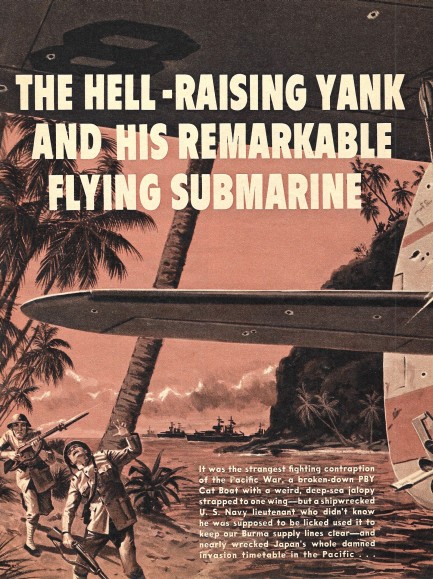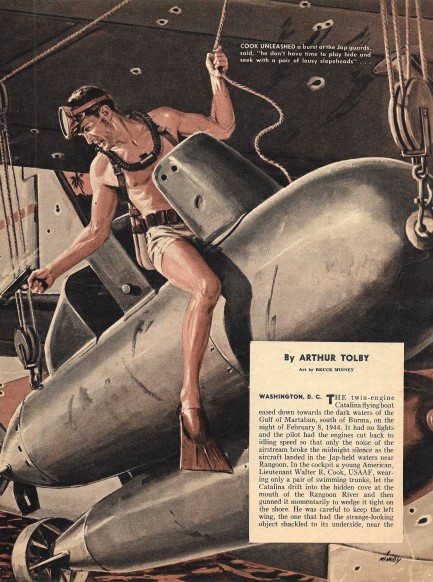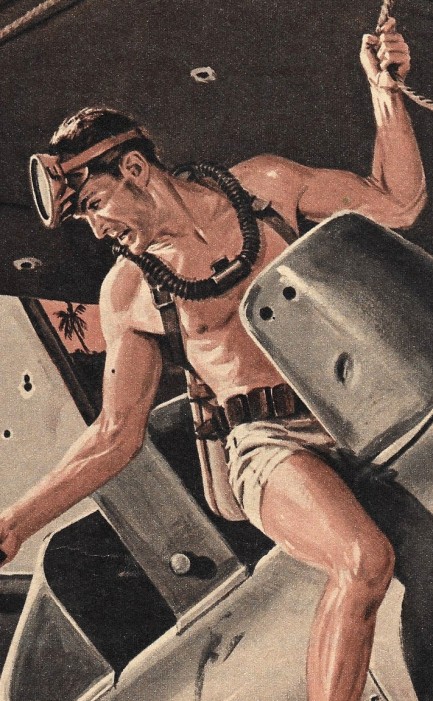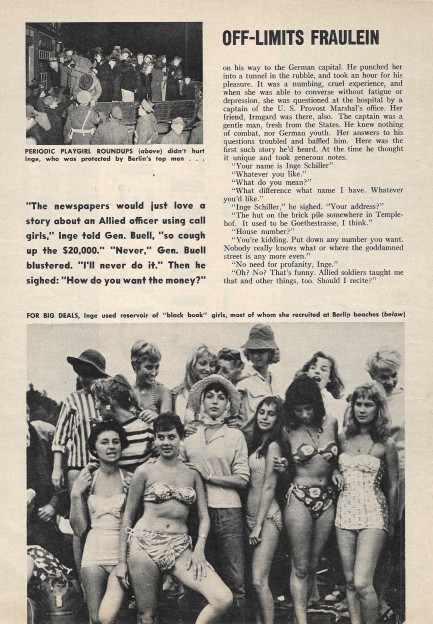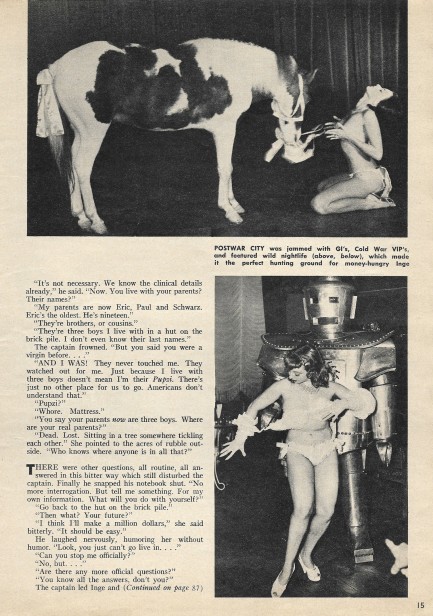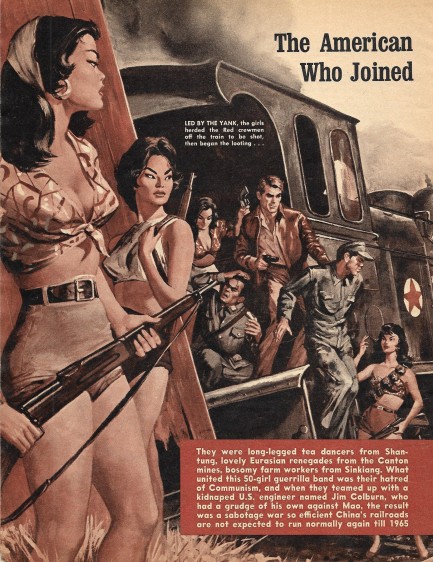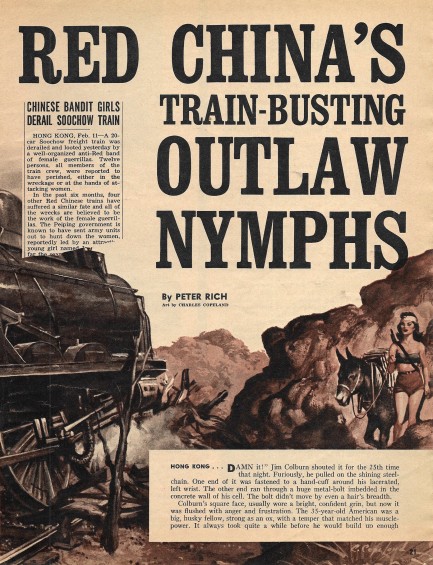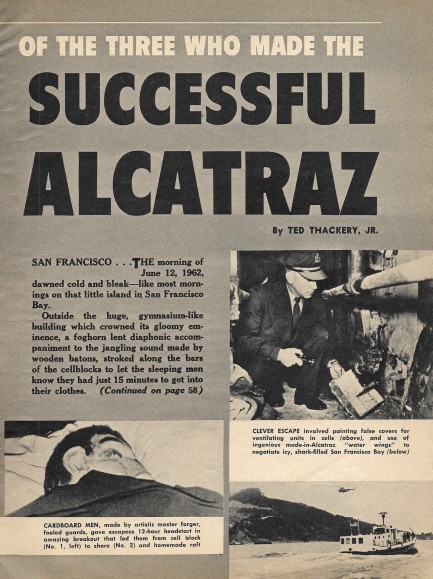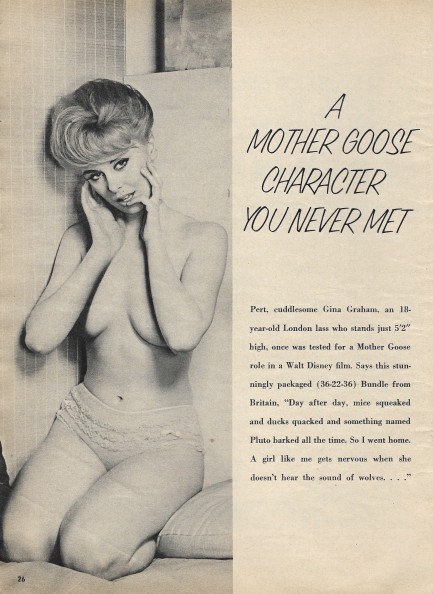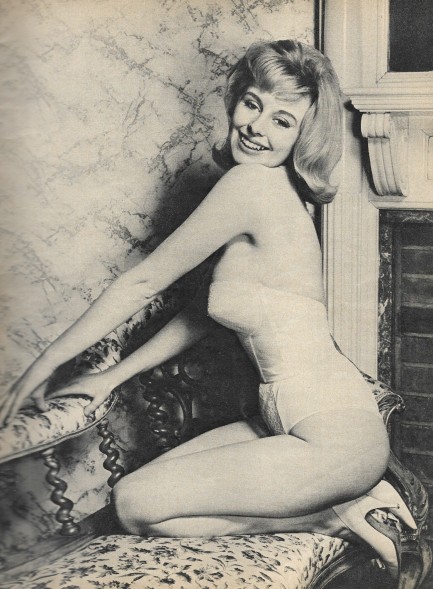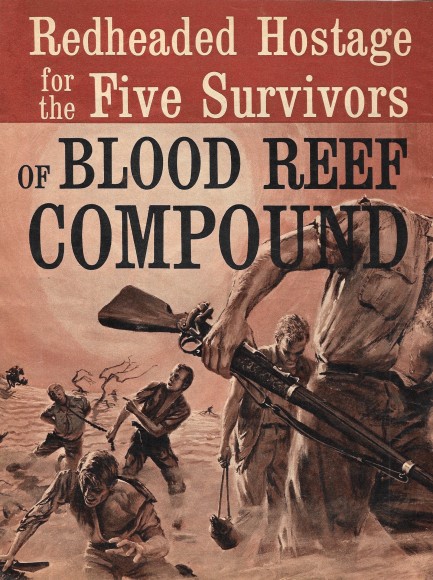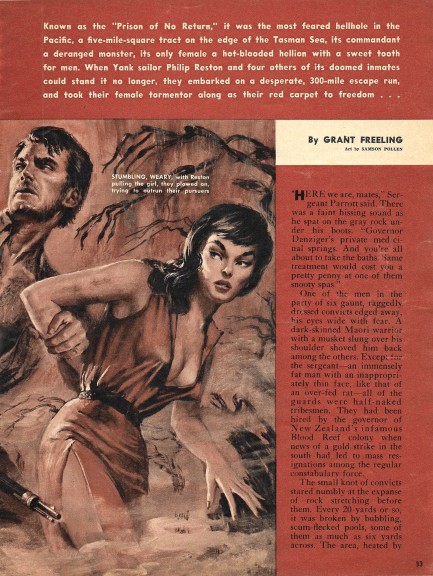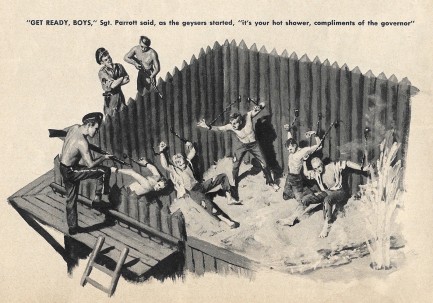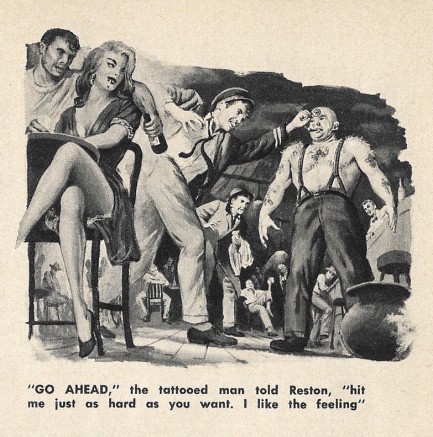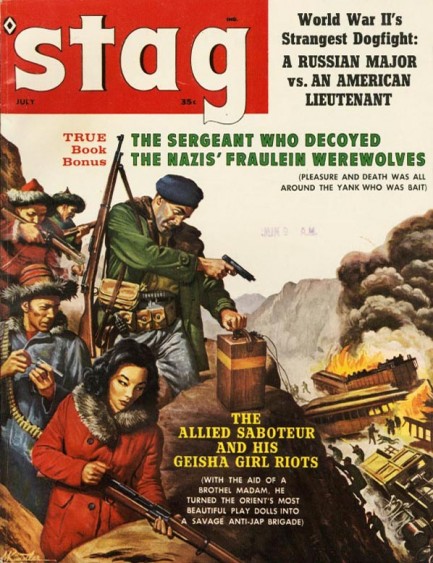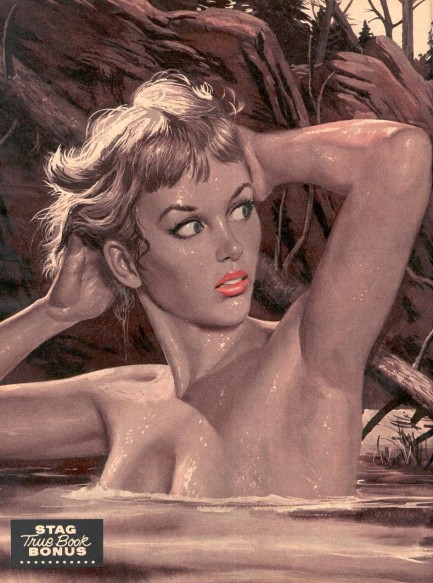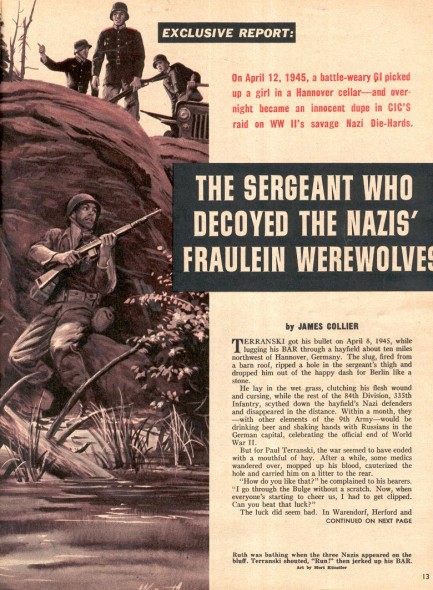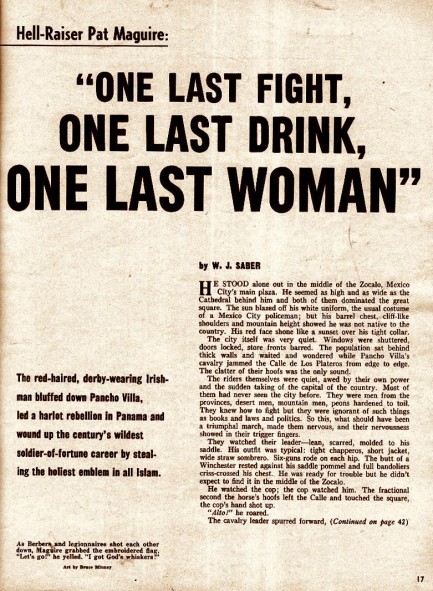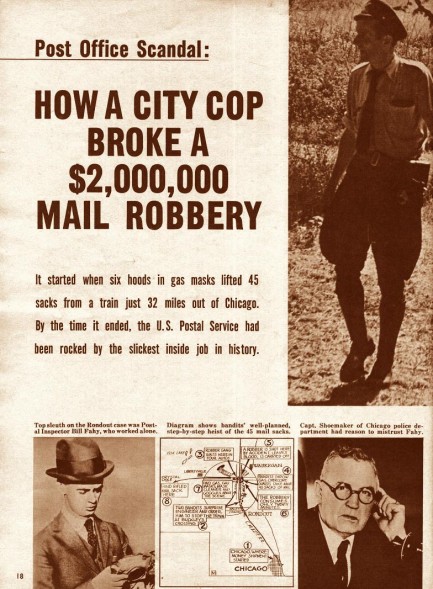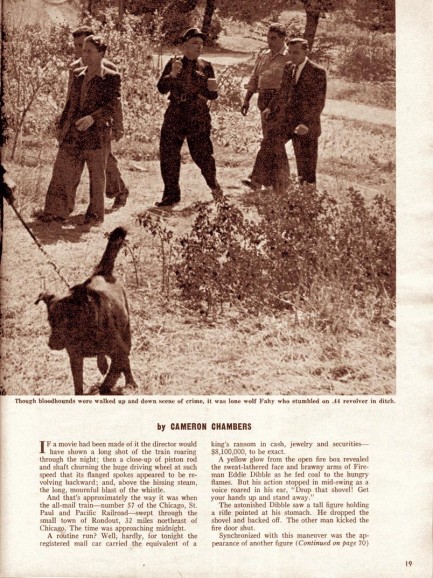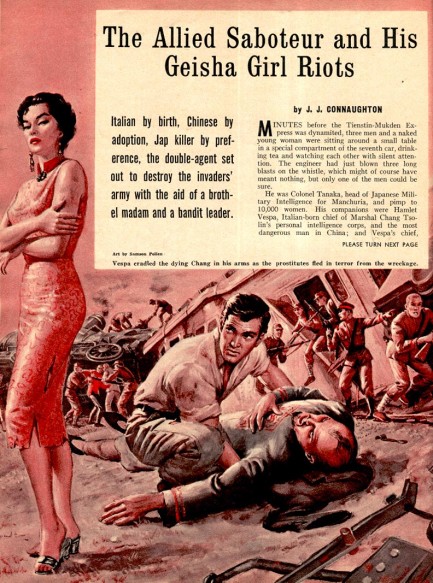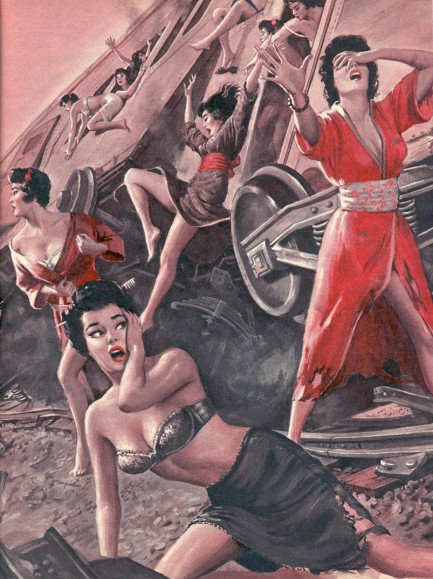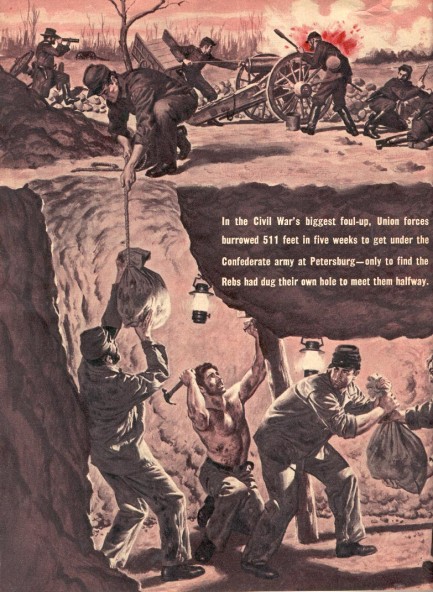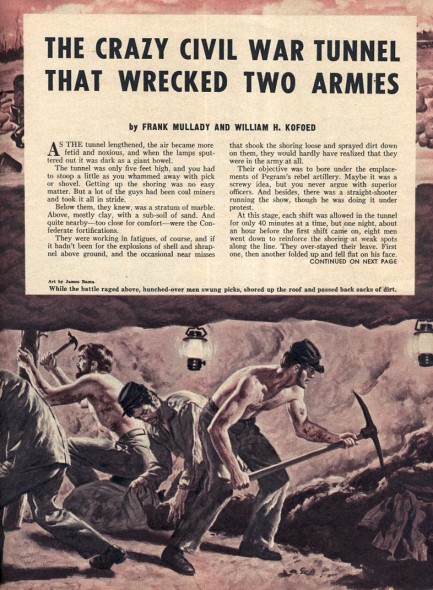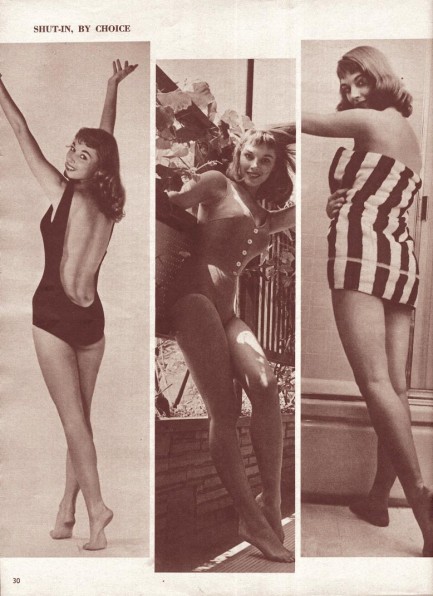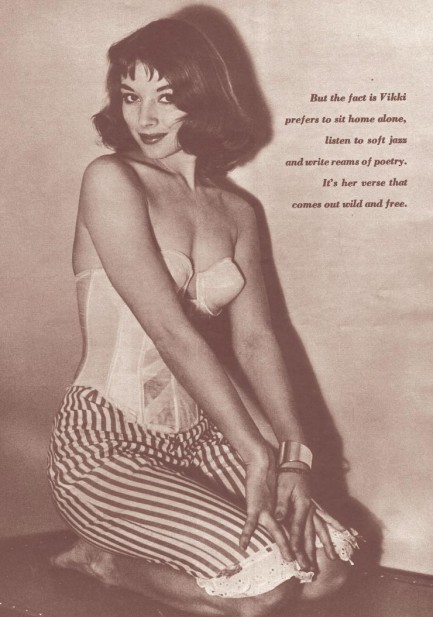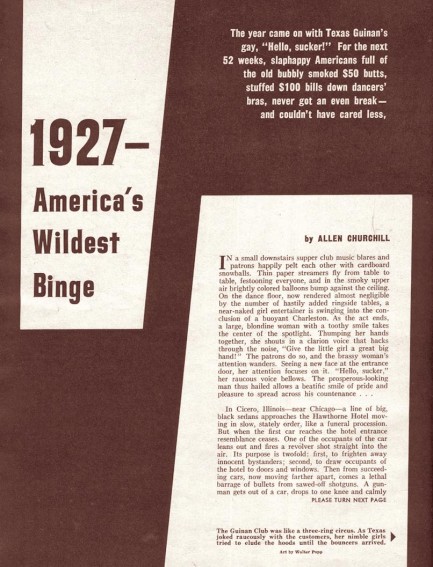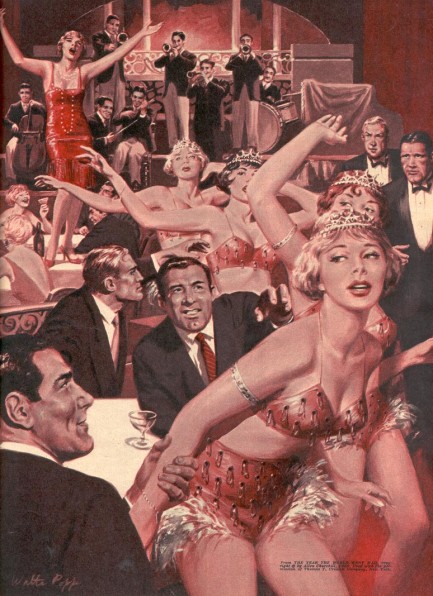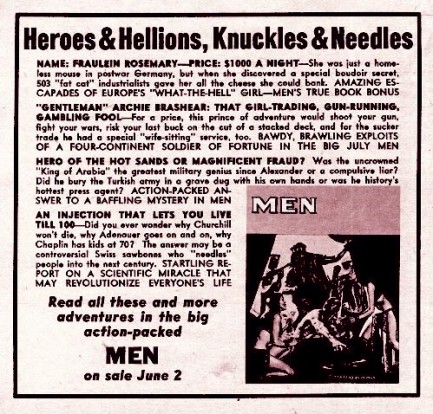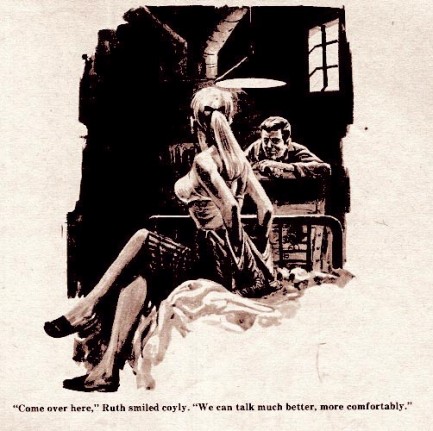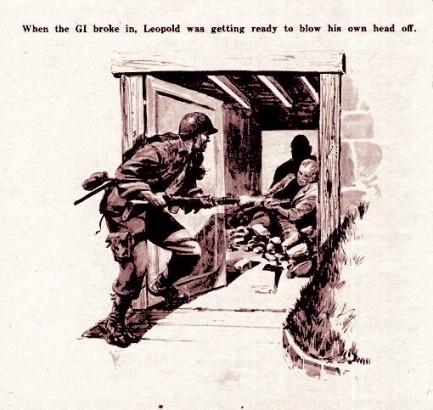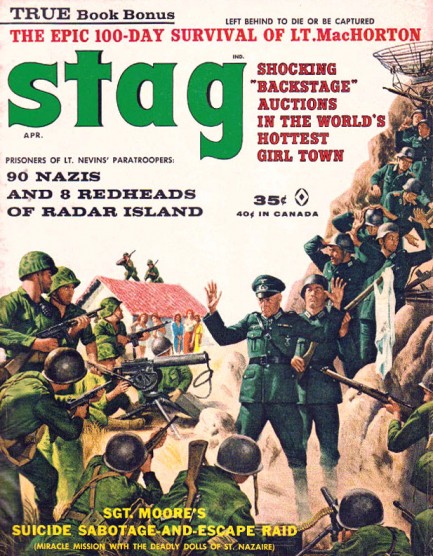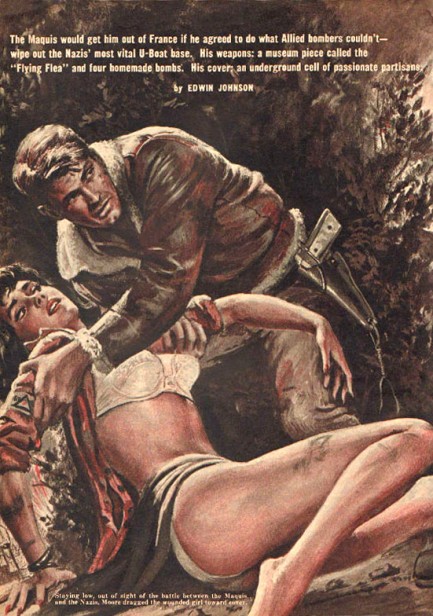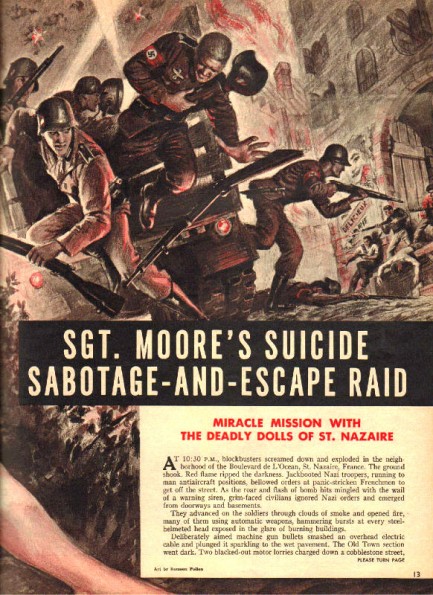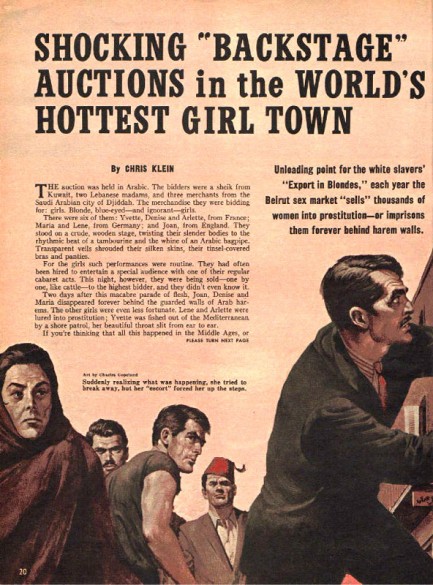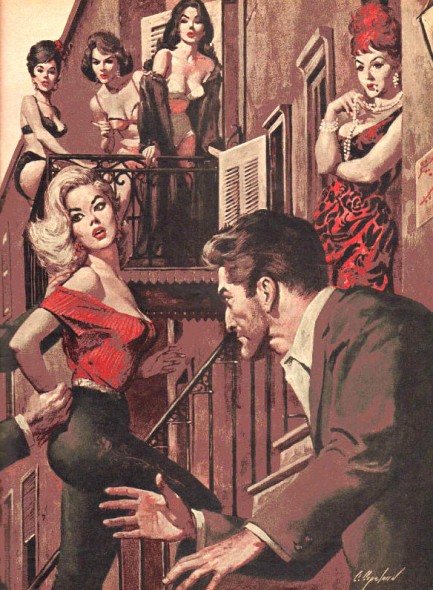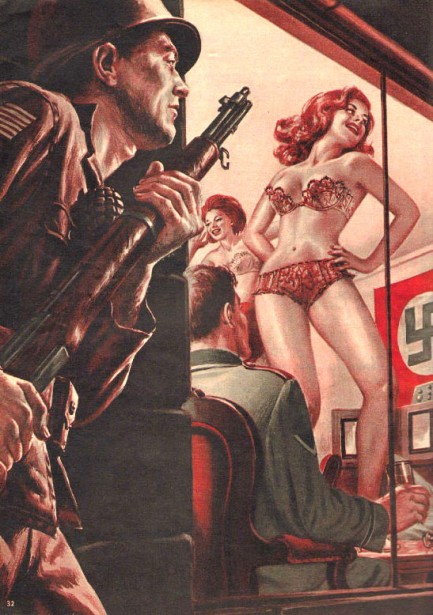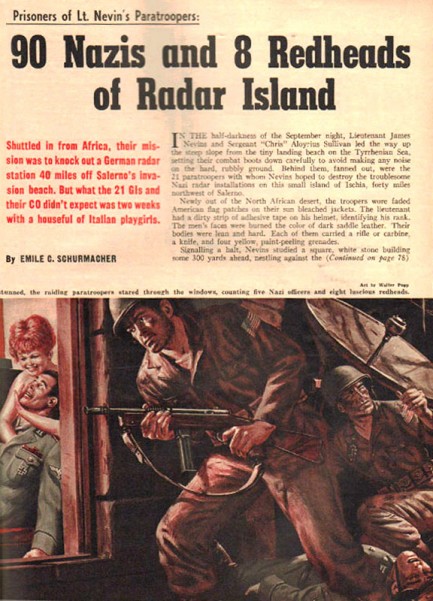 It's not comfortable, but it's reliable. 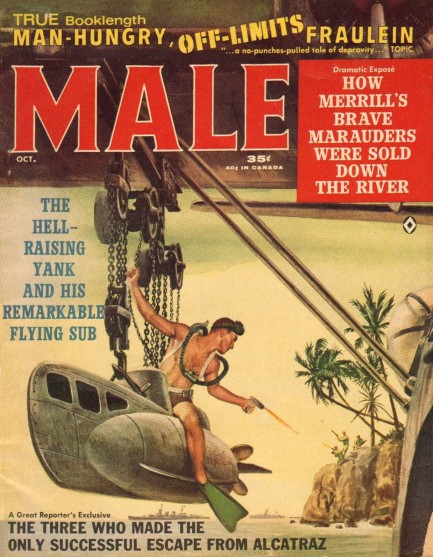
We're back to men's adventure mags today with an issue of Male from this month in 1962, with cover art by Mort Kunstler illustrating the tale, “The Hell-Raising Yank and His Remarkable Flying Sub.” We gave the story a read and it tells of Walter R. Cook, a U.S. soldier stranded in Burma who, with the aid of a local beauty (of course), finds and refurbishes an abandoned Catalina seaplane, which has attached to it a two man submarine. The sub was a type used during World War II that the operators rode like horses while breathing through scuba gear. Cook uses it to disrupt Japanese supply lines.
The story is a standard sort for an adventure magazine, but educational, since we'd never heard of rideable submarines. The illustration makes clear exactly what form it took. The magazine also offers stories set in China and New Zealand, and contains a detailed piece on an escape from Alcatraz, the very escape that inspired the Clint Eastwood film Escape from Alcatraz, involving the inmate Frank Morris, who may or may not have actually succeeded. The art throughout the issue is from the usual suspects—Charles Copeland, Samson Pollen, and Bruce Minney—and is tops as always. We have seventeen scans below.
 I'll have to go to confession later for thinking this, but my religion could use a few sweaty writhing chicks. 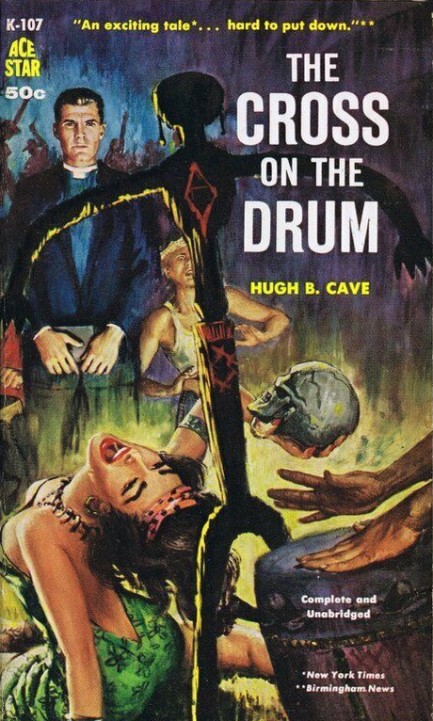
We know Hugh B. Cave as a horror writer, so when we saw this wild Samson Pollen cover for his 1959 novel The Cross on the Drum we were looking forward to some dark and scary stuff fit for the Halloween season. Unfortunately, Cave plays it straight—or as straight as you can in a voodoo novel. Basically, it's a variation on the standard South Seas tale, except set in the Caribbean on a small island called Ile du Vent, and involving a missionary who wants to civilize the locals. The book is absolutely fine aside from its built-in cultural snobbery, but it never had the weight and menace we seek from a novel of this type. In the end, how you assess it might hinge on your own beliefs. If you're a Christian you'll probably see it as a thrilling tale of moral uplift in which Jesus outshines the false gods of santería, but if you're a non-believer you'll probably see a flawed novel-length discussion of whether one primitive superstition is inherently better than another. Take a side and discuss.
 You know, every few years we vote about changing the name but just enough people in this town really are hateful. 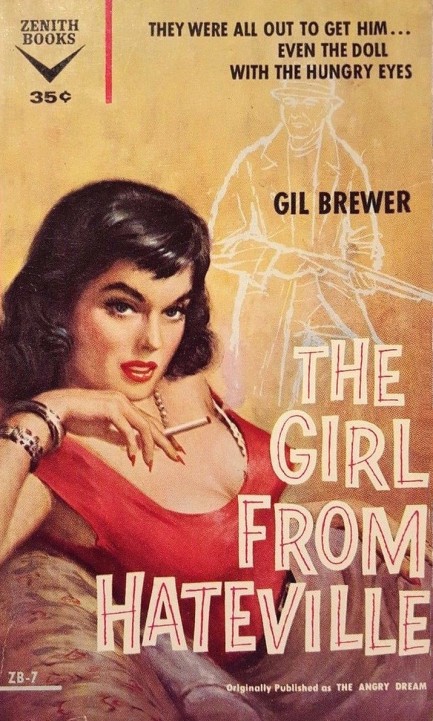
Gil Brewer's The Girl from Hateville was originally published as The Angry Dream, but this is one time changing a title was a good idea. Not only is the original title a bit limp, but Hateville is the perfect word to describe the town at the center of the narrative. These people are rabid. They're furious at the main character because his father, a banker, cost quite a few of them their savings, but geez, people—it was eight years ago and his son wasn't even living there when it happened. But that doesn't matter to the haters. They do just about every horrible thing to the guy you can imagine, even as he's trying to unravel the mystery of the missing bank funds. As hostile-hick-town-versus-innocent-man tales go, this one is pretty good, as well as unusually vicious. This Zenith edition was published in 1958 and has great Samson Pollen cover art.
 Delivering thrills all year round. 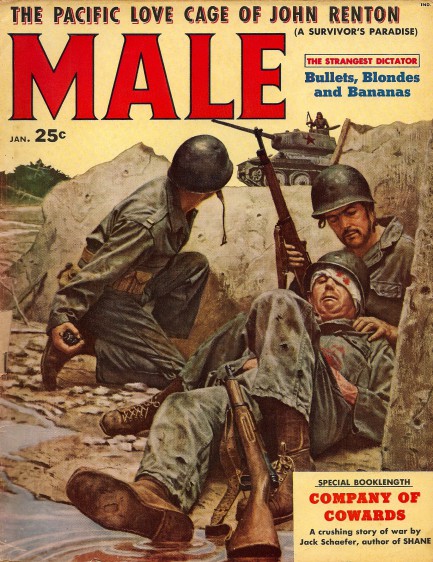
Stan Borack painted the cover of this issue of Male from January 1958, and the interior art comes from Samson Pollen, Bob Schultz, John Leone, James Bama, Bob Stanley, John Kuller, and Tom Ryan. Not a slouch in the bunch. The magazine contains a preview of Shane author Jack Schaefer’s novel Company of Cowards, the Civil War tale of a group of Union officers who have all been busted down to the rank of private, but who are formed into a special unit and given a chance to earn back their honor. That chance takes them into Comanche country where they face an assortment of deadly challenges. Also in this issue you get famed model Diane Webber/Marguerite Empey—who we’ve been seeing a lot of recently—doing a nice photo feature and complaining that since being elected Queen of the Nudists by a national sunbathing association all anyone wants to talk about is her naked lifestyle. But we think that’s just the editors trying to come up with an angle for the text. Webber was an official advocate of nudist lifestyle and even promoted her special brand of spiritual nudism in television interviews, so we doubt she was fed up with it at this point. The photos were shot by Russ Meyer, and we’re pretty sure they’ve never been on the internet before, which is always a fun moment for us. Please enjoy. Twenty scans below. 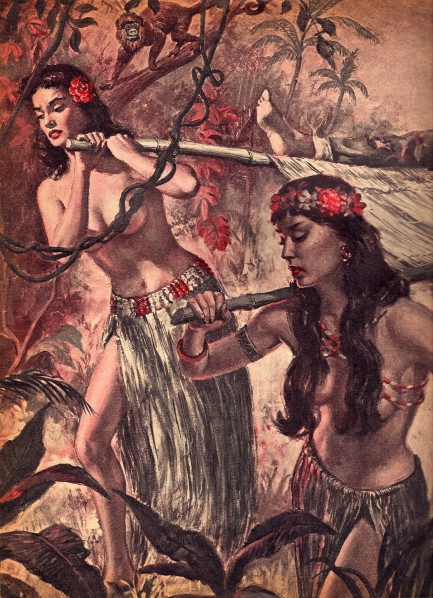 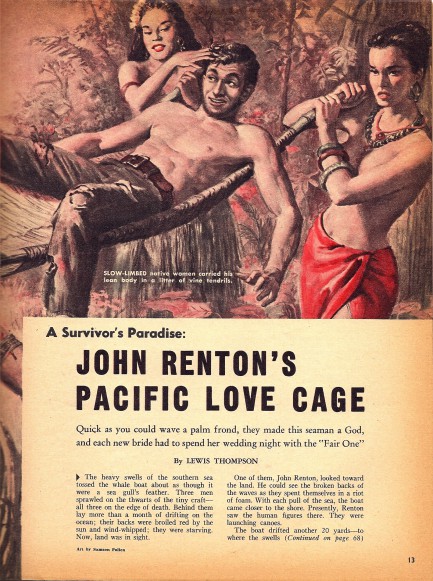 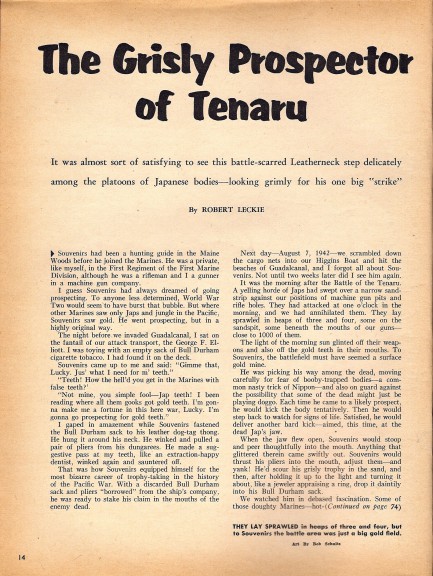 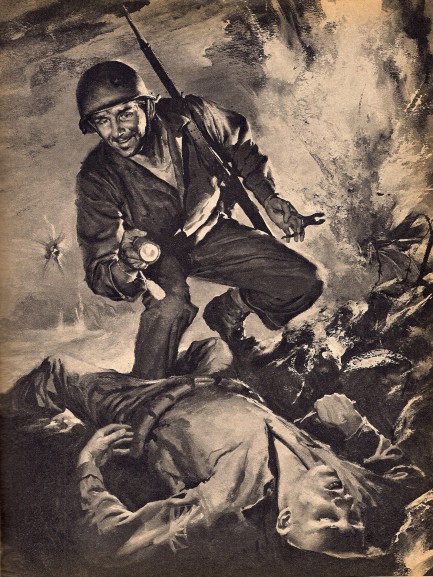 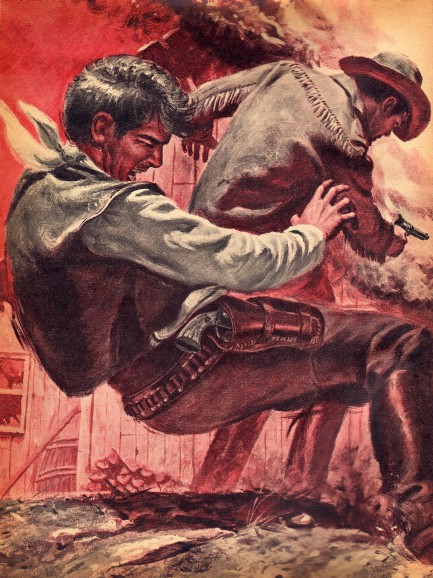 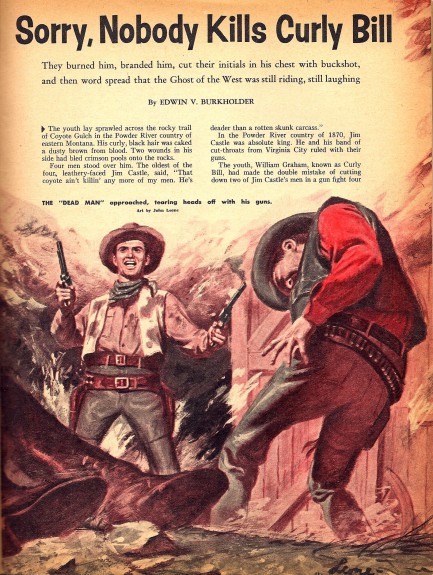 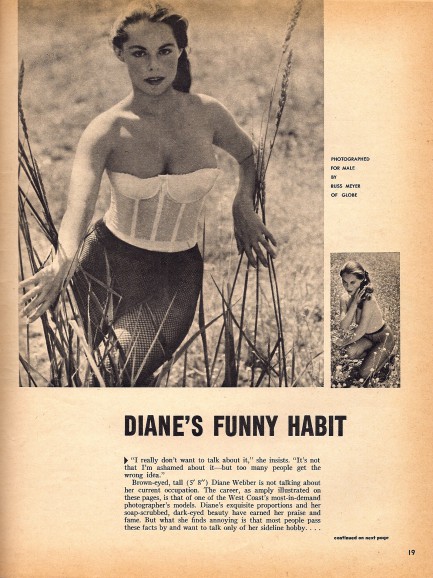 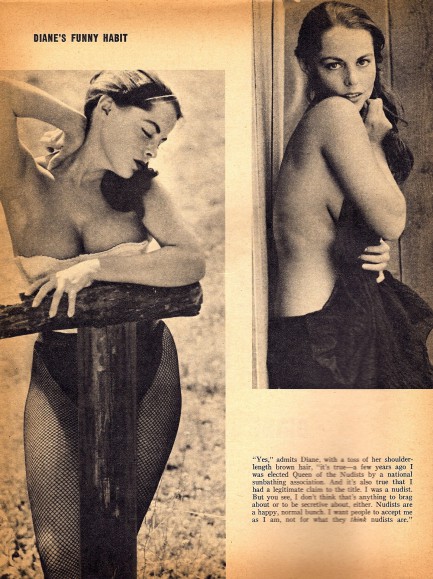 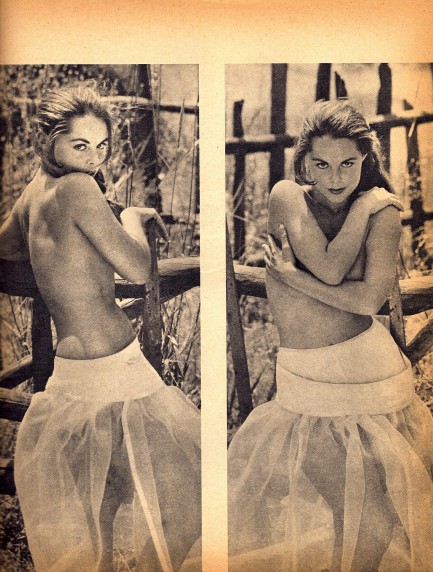 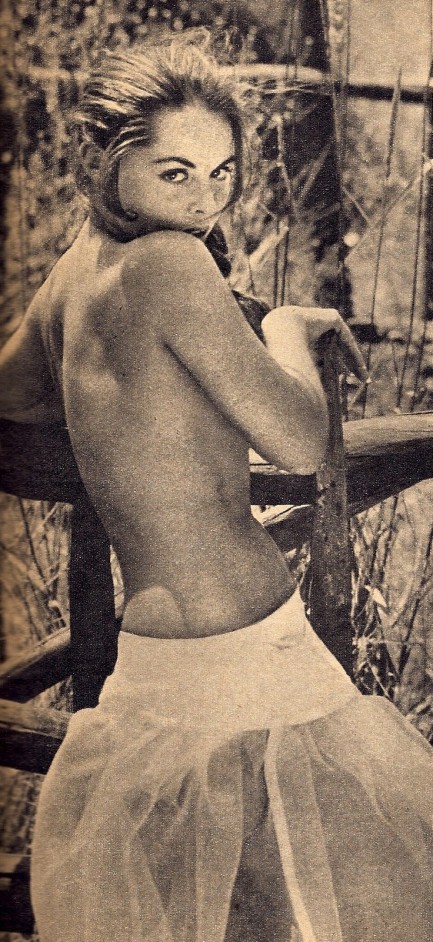 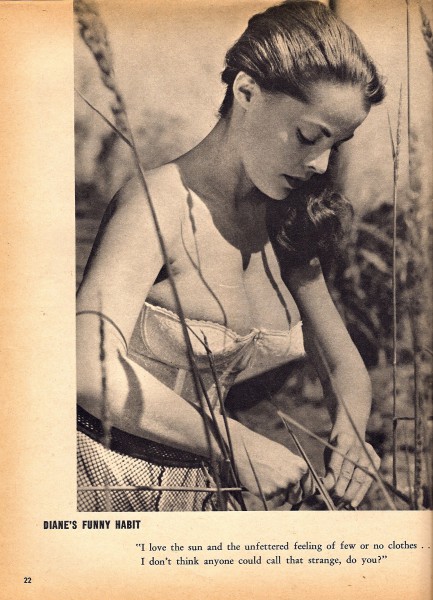  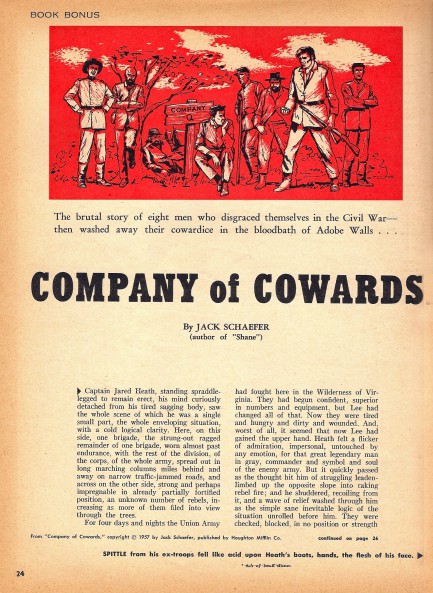 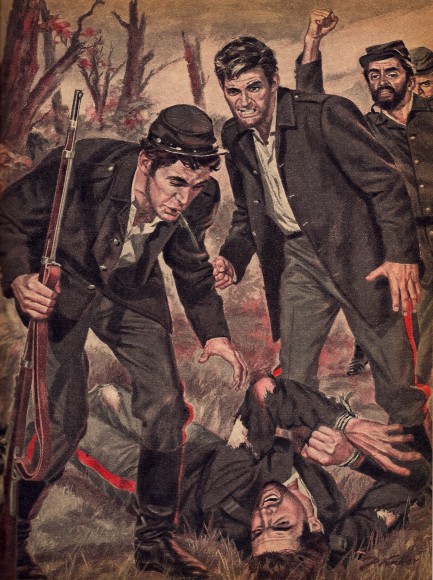 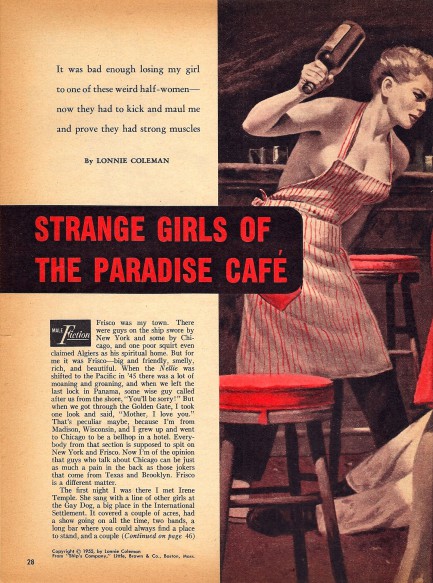 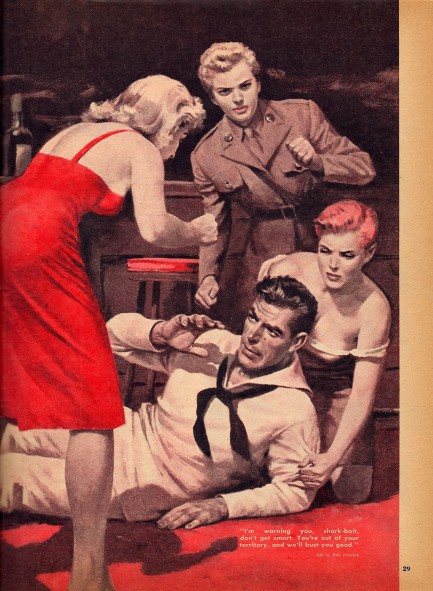 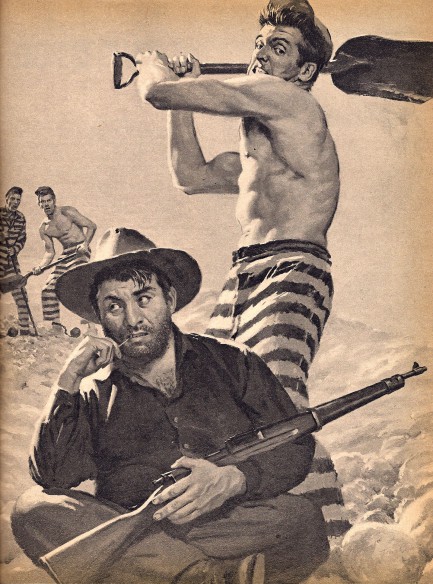 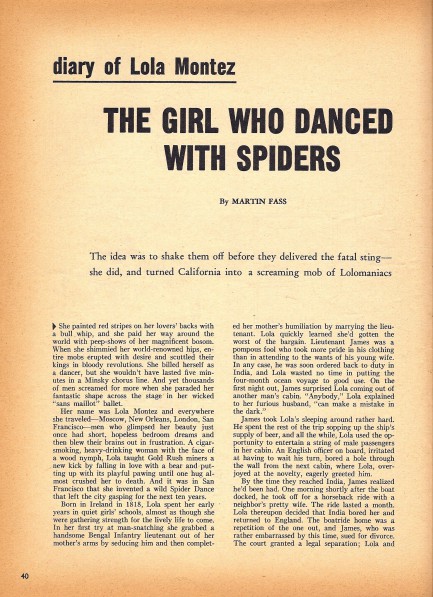 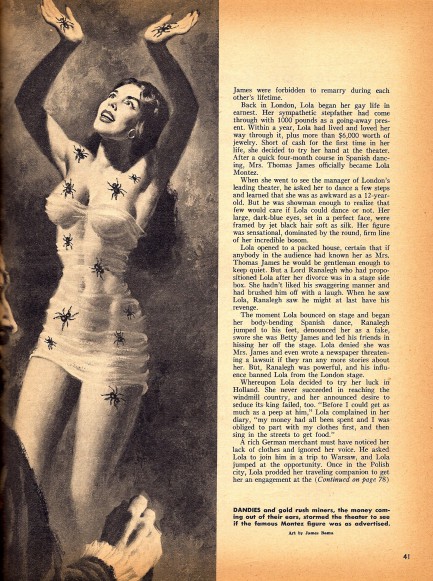 
 When in Rome kill as the Romans do. 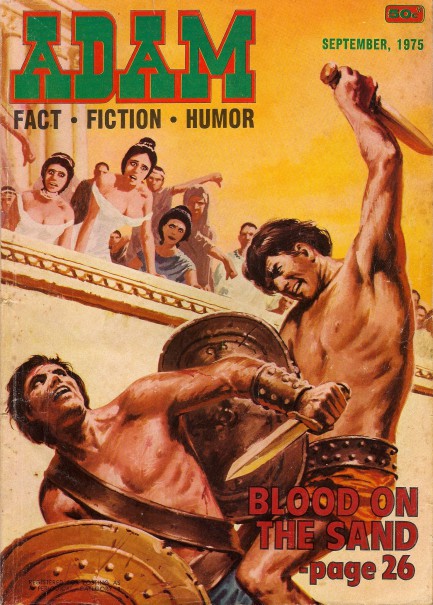
We’ve shared forty thirty-nine issues of Australia’s Adam magazine, but none since March. That isn’t because we’re running out, but merely because we decided to focus on American men’s magazines for a while. But Adam is the king as far as we’re concerned. For us, it’s the most attractive, most interesting, and—because of its penchant for stories set in the Aussie outback and wilds of South Asia—the most exotic of all the publications from the late mid-century period. Maybe that’s why we have more than 1,200 scans from the magazine tucked inside Pulp Intl. Today’s issue, number forty-one forty we’ve scanned and uploaded, has a typically lurid cover illustrating James McQueen’s story “Blood on the Sand,” which is one of the better pieces we’ve read in Adam. McQueen spins a yarn about a Roman gladiator named Marcellus who faces his best friend Helvius in the Colossuem. Helvius loses, but is spared by a thumbs-ups from the emperor. But the two friends have to fight again, they know Marcellus will win again, and they know the emperor never spares a life twice. The bulk of the story is set in the few days of contemplation and partying between the two battles. It's a very effective little tale. Elsewhere in Adam you get nice spreads from Samson Pollen and Bruce Minney, lots of thrilling fiction, and lots of naked women, including one in a soap foam bikini that reminds us of when Reiko Ike did the same. On a different subject, moving forward you may notice a break in our magazine scanning activities. Could be days or months. We have to replace our reliable old Mac with a new one and we’ll be losing our Adobe programs—i.e. no more Photoshop for cleaning scans, and we aren’t going to buy it for $1,500 because, as much as we like being one of the sites that uploads new, original content to the web, that price tag is just insane. We can still scan individual pieces of art and not need to use Photoshop on them, but magazines require retouching because the way they're bound means the scans come out skewed. If you've ever scanned one you know what we mean. We’ll see what we can do to work around the problem. In the meantime enjoy this Adam. Twenty-six images below. Update: Forty issues, thirty-nine, who can keep count? Well, we actually went back through the website and today's makes forty. Still plenty. Plus we have twenty-one more issues in reserve. Look for those down the line. 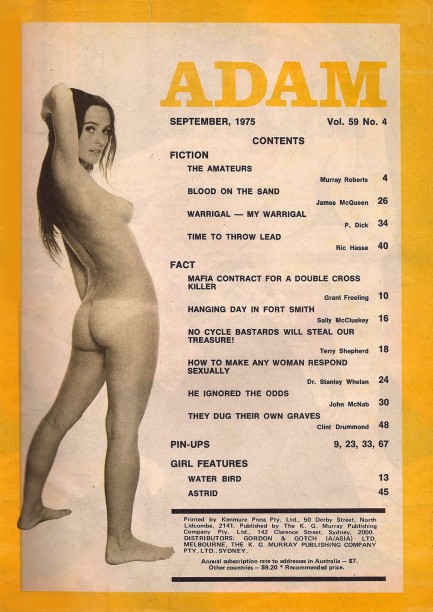 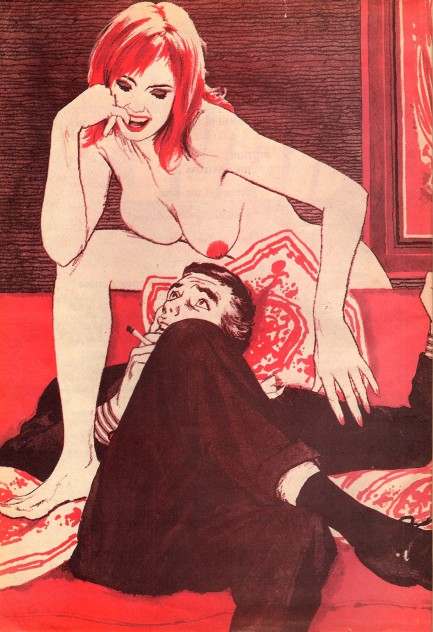 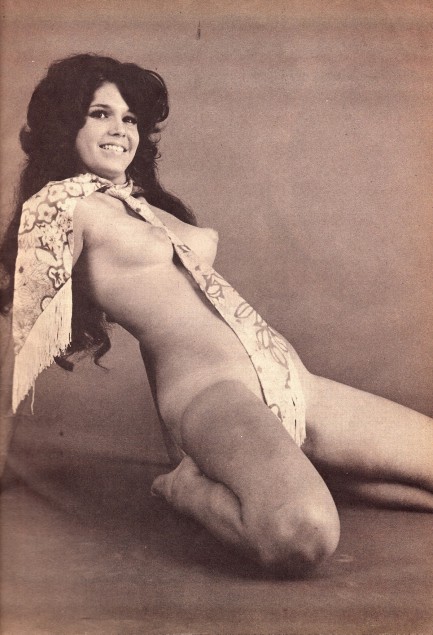 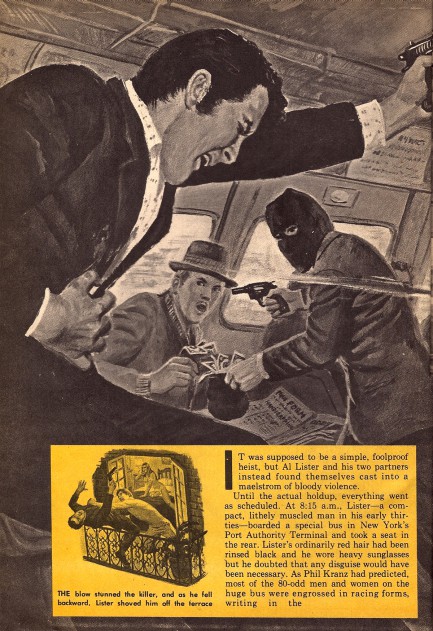 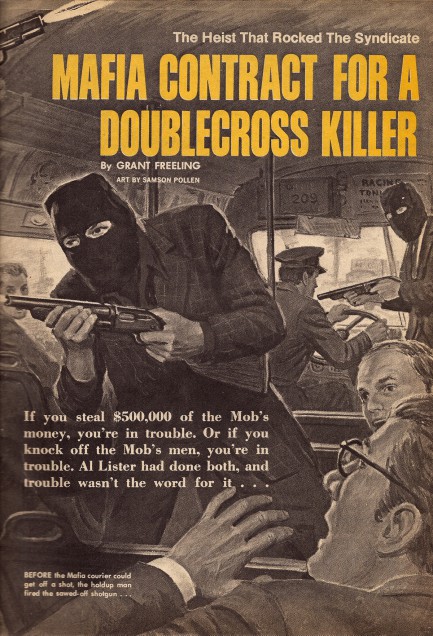    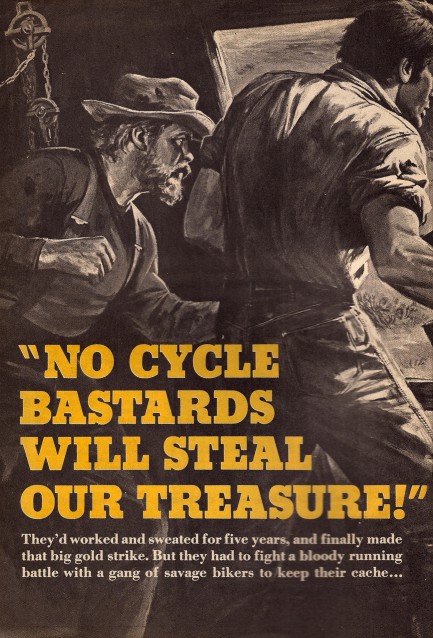 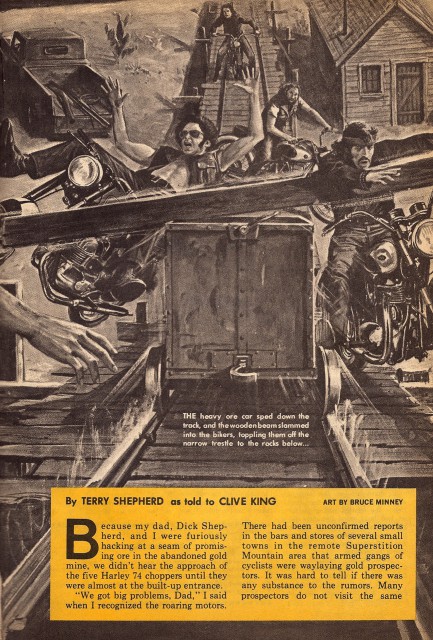 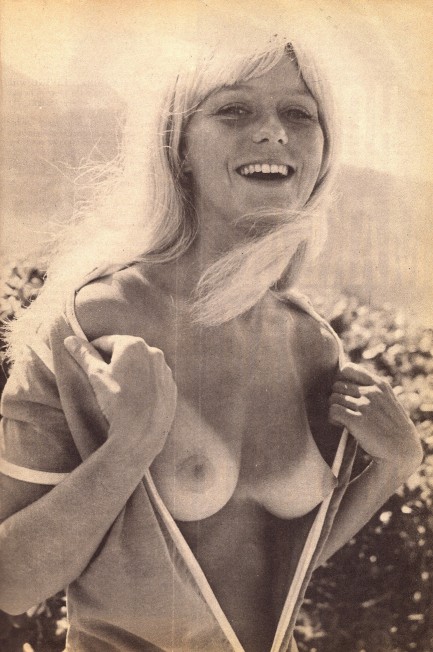 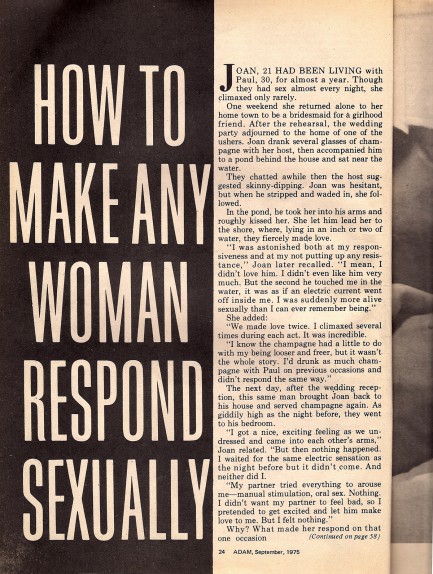 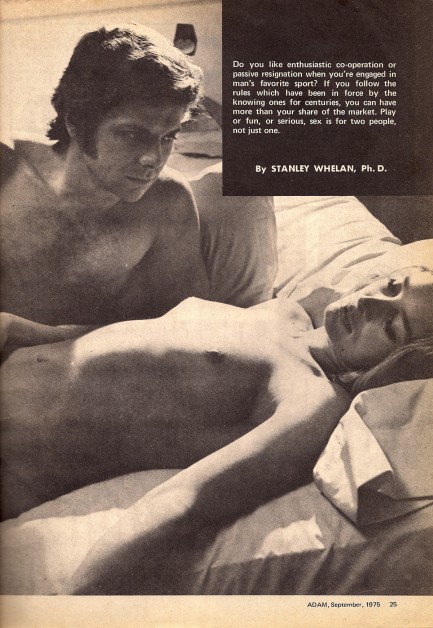 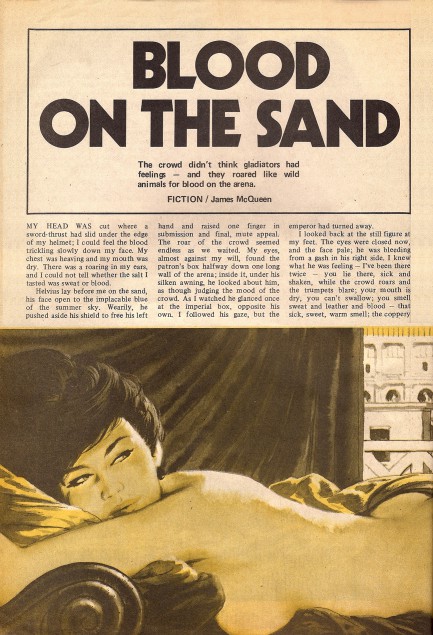 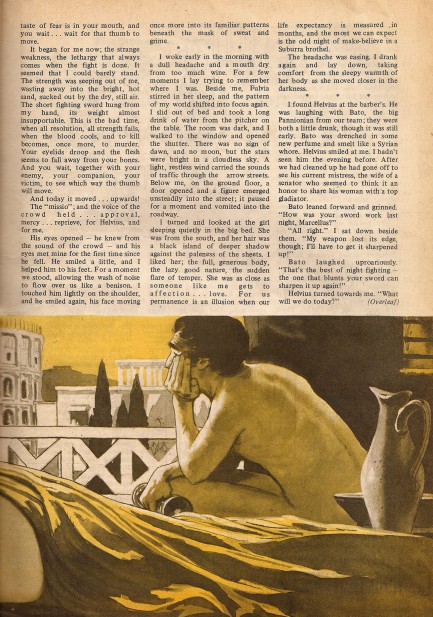  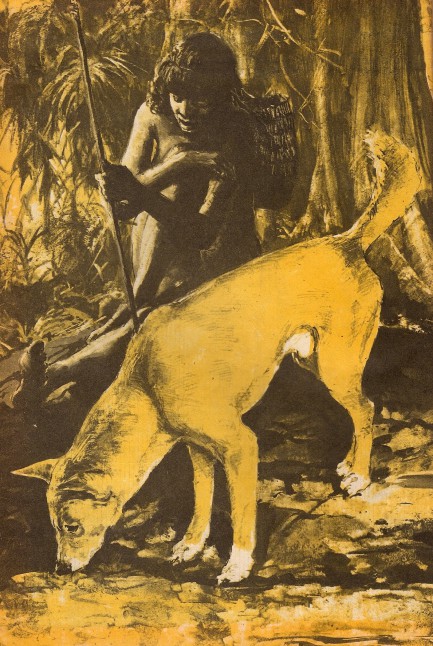 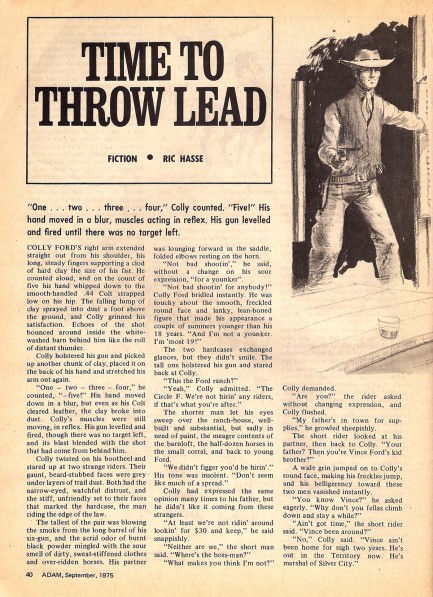 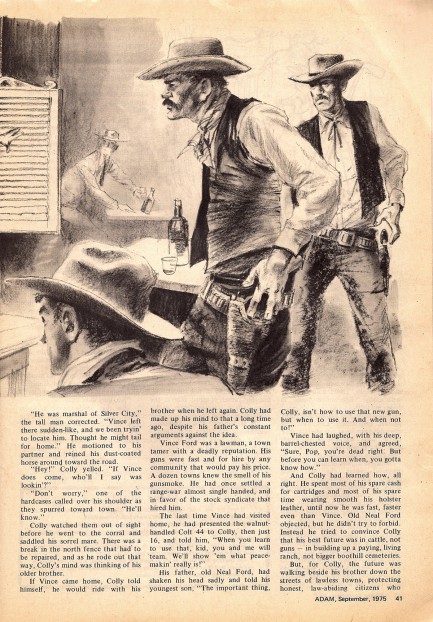    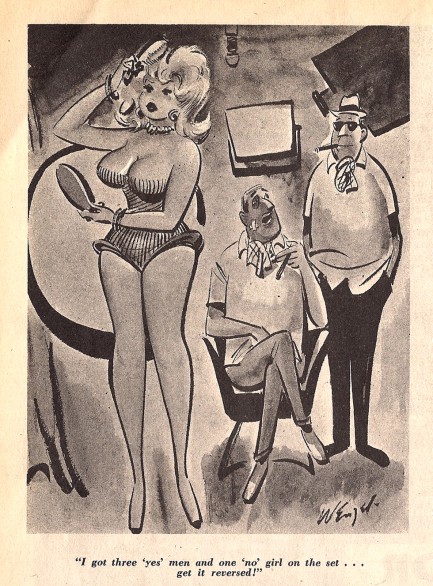 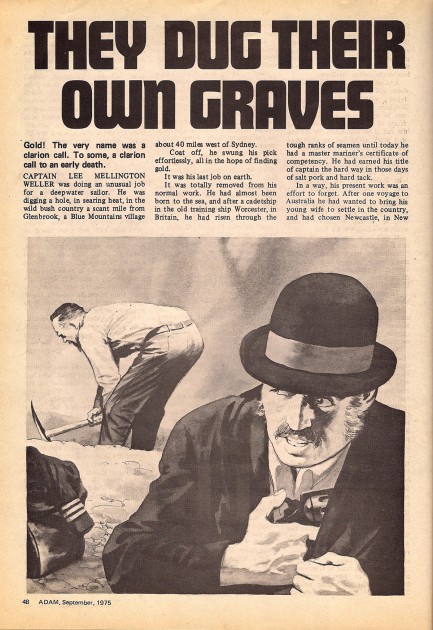 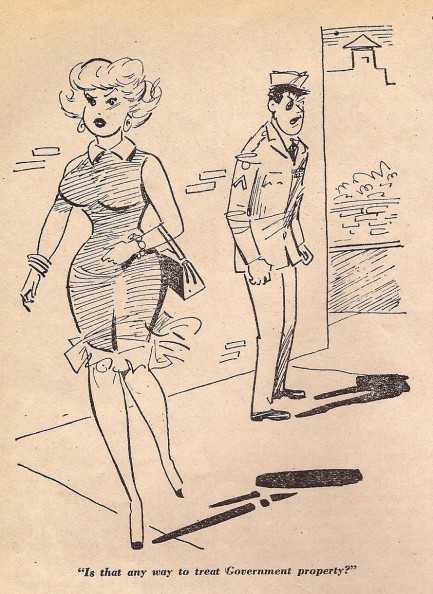 
 The Male capacity for violence. 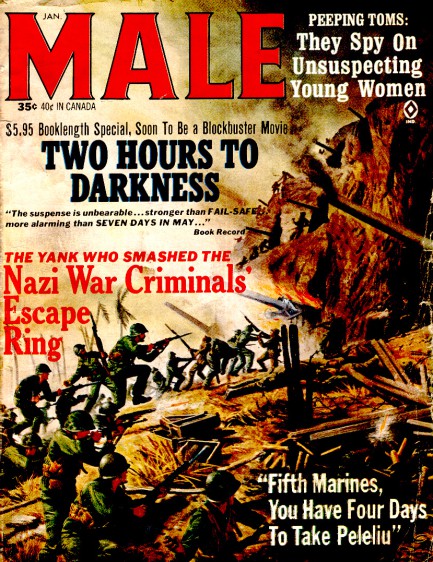
Above is a Mort Kunstler cover for Male painted for the January 1965 issue. Kunstler was famed for his war panoramas, as we’ve discussed before, and if you click his keywords below you’ll see several more martial covers from him that we’ve shared. Inside Male you also get art from Charles Copeland, Samson Pollen, and Gil Cohen. The model feature is Susan Radford, who is described as a starlet but who we’d never heard of. Turns out it wasn’t just us. We checked the usual databases and found no mention of Radford anywhere, so it seems Male editors were premature in dubbing her a major riser. Male focused on all kinds of violent adventures, but especially those dealing with warfare. This issue has four war stories dealing with the Soviet Union, China, and the Nazis, but the most notable entry is South African author Anthony Trew’s gripping Two Hours to Darkness, published here as booklength fiction. The tale is described in the contents as “the nightmarish spine-tingler that will be the movie blockbuster of 1965,” but it looks like Male was wide of the mark again, because no film based on the book was ever released. So Trew had to settle for selling a measly 3.5 million copies of the novel in sixteen languages, the hack. We have a dozen scans below.
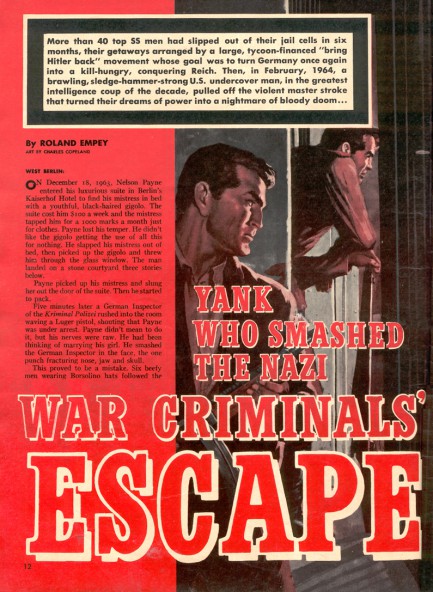 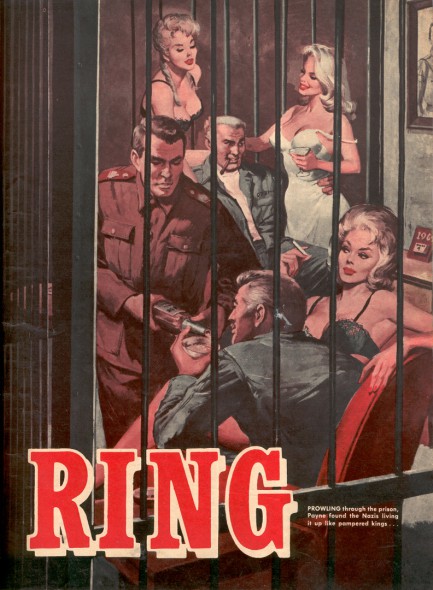 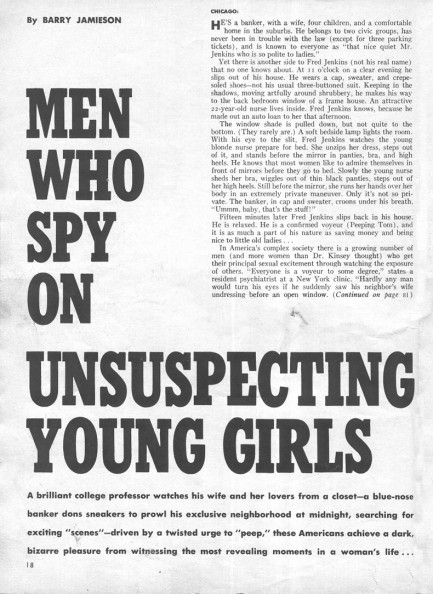 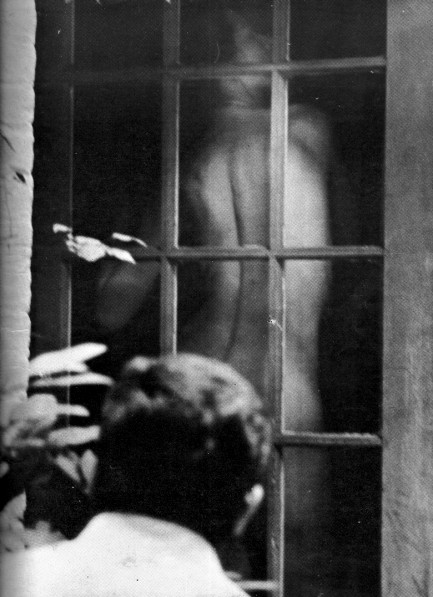 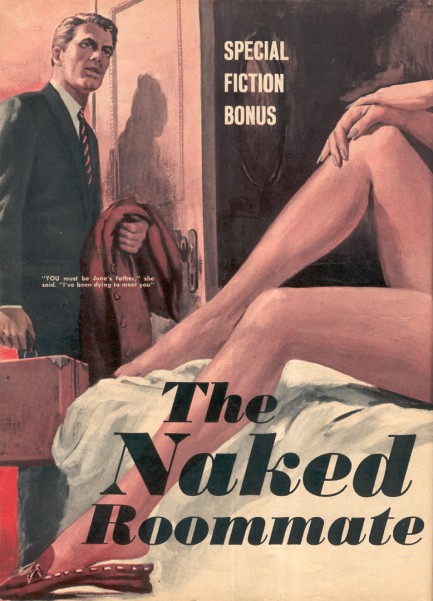 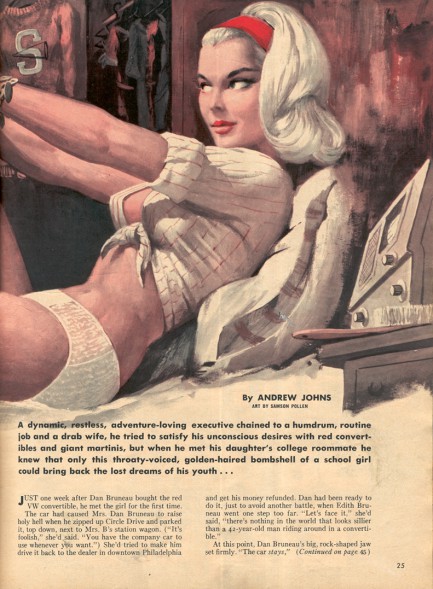 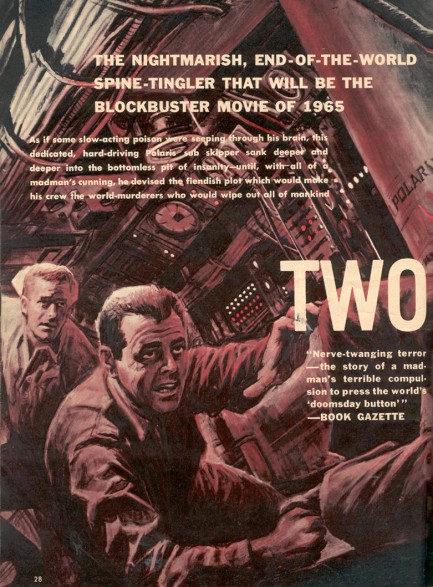 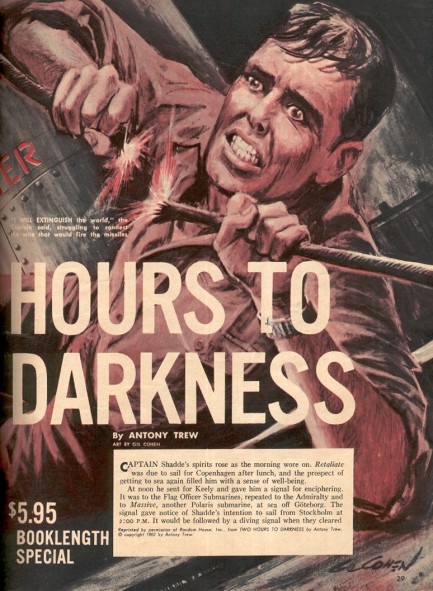  
|
 |

The headlines that mattered yesteryear.
2003—Hope Dies
Film legend Bob Hope dies of pneumonia two months after celebrating his 100th birthday. 1945—Churchill Given the Sack
In spite of admiring Winston Churchill as a great wartime leader, Britons elect
Clement Attlee the nation's new prime minister in a sweeping victory for the Labour Party over the Conservatives. 1952—Evita Peron Dies
Eva Duarte de Peron, aka Evita, wife of the president of the Argentine Republic, dies from cancer at age 33. Evita had brought the working classes into a position of political power never witnessed before, but was hated by the nation's powerful military class. She is lain to rest in Milan, Italy in a secret grave under a nun's name, but is eventually returned to Argentina for reburial beside her husband in 1974. 1943—Mussolini Calls It Quits
Italian dictator Benito Mussolini steps down as head of the armed forces and the government. It soon becomes clear that Il Duce did not relinquish power voluntarily, but was forced to resign after former Fascist colleagues turned against him. He is later installed by Germany as leader of the Italian Social Republic in the north of the country, but is killed by partisans in 1945.
|

|
|

It's easy. We have an uploader that makes it a snap. Use it to submit your art, text, header, and subhead. Your post can be funny, serious, or anything in between, as long as it's vintage pulp. You'll get a byline and experience the fleeting pride of free authorship. We'll edit your post for typos, but the rest is up to you. Click here to give us your best shot.

|
|



